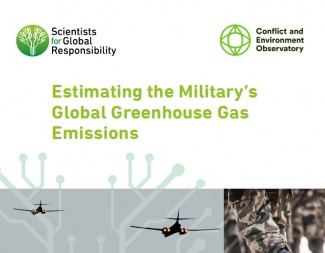An innovative new methodology for estimating global and regional military greenhouse gas emissions (GHG) suggests that the world’s militaries are responsible for 5.5% of global emissions.
Media release, 10 November 2022
According to a new report from Scientists for Global Responsibility (SGR) and the Conflict and Environment Observatory (CEOBS), this means that if the world’s militaries combined were a country, they would have the fourth largest national carbon footprint in the world – greater than that of Russia. This report is released alongside new data at militaryemissions.org which shows no year on year improvement in the quality of reporting of military emissions by governments to the United Nations.
The report ‘Estimating the military’s global greenhouse gas emissions’, uses the limited data on emissions from military vehicles, bases, and industrial supply chains that is publicly available. A lack of robust reporting and significant data gaps mean that it is inherently difficult to estimate the GHG emissions of the world’s militaries, resulting in a blind spot in global plans to tackle the climate crisis. However, this new estimate – even though significant uncertainties remain – demonstrates that the scale of these emissions is so large that concerted action to reduce them is necessary by all governments - despite the current obstacles created by wars in Ukraine and elsewhere.
The authors could not include some key sources of emissions in the estimate as the data is too poor. Examples are emissions arising from the impacts of warfighting, such as fires, other damage to infrastructure and ecosystems, post-conflict reconstruction, and healthcare for survivors. Therefore, the true scale of the ‘military carbon bootprint’ is likely to be far greater. Ahead of COP27, experts have called on the academic community to address this knowledge gap in the journal Nature.
Dr Stuart Parkinson, Executive Director of Scientists for Global Responsibility, and lead author of the report said: "The world's militaries and wars are a very significant but neglected source of carbon pollution - and these emissions are almost certainly rising with the Ukraine war and the resulting international increase in military spending. We urgently need governments and militaries to more accurately measure their emissions and more openly report them - and, just as urgently, these need to be reduced. And the most effective way of doing this is to reduce war."
Launching alongside the report is the latest data at militaryemissions.org, a website dedicated to making the data that states report to the United Nations Framework Convention on Climate Change (UNFCCC) more transparent and accessible. This year, researchers from CEOBS have re-examined the UNFCCC data submitted in 2022 (which covers data from 2020) and found no annual improvement in the provision or overall transparency in military fuel use data.
Following an agreement under the 1997 Kyoto Protocol, militaries have no obligations to report their international emissions to the UNFCCC and many countries continue to not provide any military data at all - including some of the top 10 military spenders such as India, Saudi Arabia and South Korea. The data submitted indicated lower GHG emissions from mobile military fuel use for some countries, as expected during the COVID-19 pandemic, but an increase in emissions has been reported by 10 nations (Australia, Cyprus, Czechia, Denmark, Greece, Hungary, Italy, Netherlands, Switzerland and Ukraine). However, for countries that choose to voluntarily submit data, we find this reporting to be incomplete, generally unclear and highly inconsistent between countries.
Linsey Cottrell, Environmental Policy Officer at CEOBS said that: “The bar is pretty low for current reporting requirements to the UNFCCC for military fuel use, but most of the top military spending countries are failing to even meet this low standard. As a first step, we need the UNFCCC to strengthen its reporting protocols for governments’ militaries.”
Notes for editors
- The full report is published on Thursday 10th November 2022 and is available at:
- Scientists for Global Responsibility (SGR) is a UK membership organisation of hundreds of scientists and engineers promoting responsible science and technology through research, education and advocacy.
- Web: https://www.sgr.org.uk/
- Twitter: @ResponsibleSci
- The Conflict and Environment Observatory (CEOBS) is a UK charity that undertakes research and advocacy on the environmental dimensions of armed conflicts and military activities.
- Web: http://www.ceobs.org
- Twitter: @detoxconflict
- The Military Emissions Gap is a joint project by The Conflict and Environment Observatory and Concrete Impacts.
- Web: https://militaryemissions.org
- Twitter: @milemissionsgap
